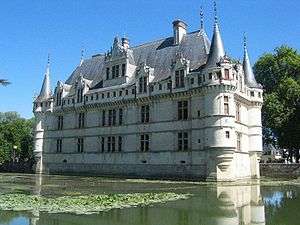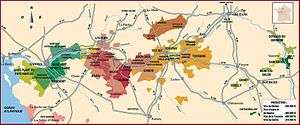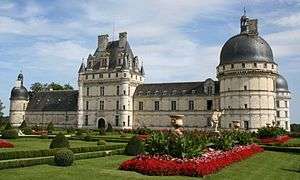Loire Valley
| The Loire Valley between Sully-sur-Loire and Chalonnes | |
|---|---|
| Name as inscribed on the World Heritage List | |
 Château d'Azay-le-Rideau Château d'Azay-le-Rideau | |
| Type | Cultural |
| Criteria | i, ii, iv |
| Reference | 933 |
| UNESCO region | Central France |
| Inscription history | |
| Inscription | 2000 (24th Session) |
The Loire Valley (French: Vallée de la Loire, pronounced: [va.le də la lwaːʁ]), spanning 280 kilometres (170 mi), is located in the middle stretch of the Loire River in central France, primarily within the administrative region named Centre-Val de Loire. The area of the Loire Valley comprises about 800 square kilometres (310 sq mi).[1] It is referred to as the Cradle of the French and the Garden of France due to the abundance of vineyards, fruit orchards (such as cherries), and artichoke, and asparagus fields, which line the banks of the river.[2] Notable for its historic towns, architecture, and wines, the valley has been inhabited since the Middle Palaeolithic period.[1] In 2000, UNESCO added the central part of the Loire River valley to its list of World Heritage Sites.
Geography and climate
The valley includes historic towns such as Amboise, Angers, Blois, Chinon, Orléans, Saumur, and Tours.
The climate is favorable most of the year, the river often acting as a line of demarcation in France's weather between the northern climate and the southern.[3] The river has a significant effect on the mesoclimate of the region, adding a few degrees of temperature. The climate can be cool with springtime frost while wine harvest months may have rain.[4] Summers are hot; however, influences from the Atlantic moderate the temperature with breezes.[5]
Temperature, rainfall and average sunshine time in Angers (Anjou):
| Month | Jan | Feb | March | Apr | May | June | July | Aug | Sept | Oct | Nov | Dec | Year |
|---|---|---|---|---|---|---|---|---|---|---|---|---|---|
| Average minimum temperature (°C) | 2.1 | 2.2 | 3.9 | 5.6 | 8.9 | 11.8 | 13.6 | 13.4 | 11.3 | 8.4 | 4.6 | 2.8 | 7.4 |
| Average temperature (°C) | 5 | 5.7 | 8.2 | 10.4 | 13.9 | 16.2 | 19.2 | 19.1 | 16.5 | 12.7 | 8 | 5.6 | 11.8 |
| Average maximum temperature (°C) | 7.9 | 9.2 | 12.6 | 15.3 | 19 | 22.6 | 24.9 | 24.7 | 21.8 | 17 | 11.4 | 8.4 | 16.2 |
| Average monthly rainfall (mm) | 62.1 | 50.8 | 51.7 | 44.6 | 54.4 | 41.2 | 43.8 | 44.9 | 52.2 | 59.6 | 64.5 | 63.4 | 633.4 |
| Monthly hours of sunshine (hour/month) | 70 | 92 | 141 | 179 | 201 | 234 | 248 | 237 | 191 | 129 | 89 | 65 | 1877 |
| Source:[6] | |||||||||||||
Wine

The Loire Valley wine region[7] is one of the world's most well-known areas of wine production and includes several French wine regions situated along the river from the Muscadet region on the Atlantic coast to the regions of Sancerre and Pouilly-Fumé just southeast of the city of Orléans in north central France. Loire wines tend to exhibit a characteristic fruitiness with fresh, crisp flavors.[8]
Culture
On December 2, 2000, UNESCO added the central part of the river valley, between Chalonnes-sur-Loire and Sully-sur-Loire, to its list of World Heritage Sites. In choosing this area that includes the French départements of Loiret, Loir-et-Cher, Indre-et-Loire, and Maine-et-Loire, the committee said that the Loire Valley is: "an exceptional cultural landscape, of great beauty, comprised of historic cities and villages, great architectural monuments - the châteaux - and lands that have been cultivated and shaped by centuries of interaction between local populations and their physical environment, in particular the Loire itself."
The Loire Valley chansonniers are a related group of songbooks attributed to the composers of the Loire Valley and are the earliest surviving examples of a new genre which offered a combination of words, music, and illuminations.[9]
Architecture
The architectural heritage in the valley's historic towns is notable, especially its châteaux, such as the Château d'Amboise, Château d'Azay-le-Rideau, Château de Chambord, Château de Chinon, Château du Rivau, Château d'Ussé, Château de Villandry and Chenonceau. The châteaux, numbering more than three hundred, represent a nation of builders starting with the necessary castle fortifications in the 10th century to the splendour of those built half a millennium later. When the French kings began constructing their huge châteaux here, the nobility, not wanting or even daring to be far from the seat of power, followed suit. Their presence in the lush, fertile valley began attracting the very best landscape designers. In addition to its many châteaux, the cultural monuments illustrate to an exceptional degree the ideals of the Renaissance and the Age of the Enlightenment on western European thought and design. Many of the châteaux were designed to be built on the top of hills, one example of this is the Château d'Amboise. Many of the châteaux had extremely detailed and expensive churches on the grounds, or within the actual château itself.
References
- 1 2 Tockner, Klement; Uehlinger, Urs; Robinson, Christopher T. (2009). Rivers of Europe. Academic Press. p. 183. ISBN 978-0-12-369449-2. Retrieved 11 April 2011.
- ↑ Williams, Nicola; Boone, Virginie (1 May 2002). The Loire. Lonely Planet. pp. 7–10. ISBN 978-1-86450-358-6. Retrieved 12 April 2011.
- ↑ "Loire Valley". hall.org. Retrieved 12 April 2011.
- ↑ J. Robinson (ed.) The Oxford Companion to Wine, Third Edition pp. 408–410, Oxford University Press, 2006. ISBN 0-19-860990-6
- ↑ "Loire Valley weather". Retrieved 12 April 2011.
- ↑ Climatology from 1947 to 2008 - Angers, France
- ↑ Vineyard in the Loire Valley, map.
- ↑ C. Fallis, editor The Encyclopedic Atlas of Wine pg 168-176 Global Book Publishing 2006 ISBN 1-74048-050-3
- ↑ "Short Description for Songs, Scribes, and Society". bookdepository.com. Retrieved 11 April 2011.
External links
| Wikivoyage has a travel guide for Loire Valley. |
- Loire Valley world heritage site
- Loire Valley Chateau du Rivau
- Chinon Fortress
- Western France Tourist Board
Coordinates: 47°23′56″N 0°42′10″E / 47.39889°N 0.70278°E
